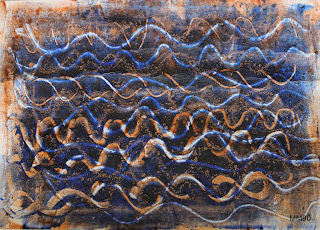- each surface was given an initial coating of white matt emulsion to both seal the card before the starch paste was applied and also to give a medieval look,
- brusho was used to colour the paste in all but the last sample, ultramarine for the first layer and gamboge for the second,
- the paste was spread with a small squeegee and marks were made with mini bamboo skewers - both the sharp and blunt ends, cardboard edges with shapes cut and cocktail sticks. Metallic layers were added as detailed below.
Sample 1
Sample 2
Sample 3
Sample 4
Sample 5
Sample 6
Sample 7
Sample 8
Metallic - Stabilo gold crayon, green and red metallic rub-ons
Metallic - PlayArt silver wax crayon and copper metallic rub-on on right hand side only
Sample 2
Metallic - gold acrylic applied with dry sponge and then wiped off in places with wet cloth
Sample 3
Metallic - graphite stick
Sample 4
Metallic - copper Neocolour2
Sample 5
Metallic - PlayArt silver wax crayon
Sample 6
Metallic - copper and silver Derwent metallic crayons
Sample 7
Metallic - PlayArt copper wax crayon
Sample 8
Metallic - Stabilo gold crayon, green and red metallic rub-ons




























No comments:
Post a Comment